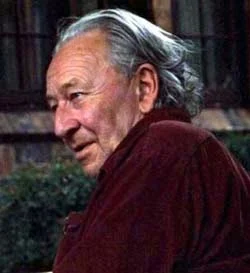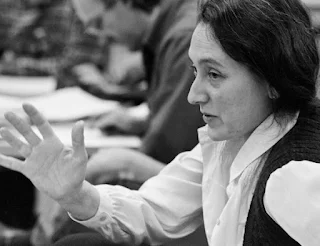People made machines that worked, and then made the machines into metaphors to explain how everything works.
For example, the metaphor of the clock. It dominated the long era of Newtonian mechanics. Everything became clockworks.Then the steam engine, the dynamo, and so on. The mindless machine and the Industrial Revolution is said to have called forth a mechanistic theory of evolution from Wallace and Darwin.
In my 1950s childhood the human brain and body was a telephone exchange. Then came calculating machines, and the brain became a computer. A biological analogue was supposed to be the gene, with its digital off/on switch. It ran the whole show, even of change over millions of years called evolution.
Once these images became less novel and dominant, the points where the metaphor didn’t hold became clearer. Genetics turned out to be more complex, as did evolution. And not even a telephone exchange is a telephone exchange anymore.
Then in the 1970s, Gregory Bateson suggested a model which as a metaphor seems to explain a lot that’s left out of these other metaphors. For these other metaphors were based on insights and techniques that enabled humans to do things. Because they enabled humans to do things, they must be the keys to reality. But while they increased our capabilities, they did not necessarily complete our understanding, though these metaphors were seldom recognized as limited or partial.
Bateson’s metaphor was also a kind of machine, one of deceptive simplicity. It was the humble thermostat.
The familiar thermostat includes three basic components: a thermometer that measures ambient temperature (for instance, in a room or a house), a dial or other device that a person uses to set a desired temperature, and an internal device that makes use of the different thermal properties of two metals to sense the difference between the desired temperature and the measured temperature. When the actual falls below the desired, the device turns on the heat, and shuts it off when the two are approximately the same.What the thermostat achieves is homeostasis, which sounds like it means a stable home, and it almost does mean that. Homeostasis is defined as a process to actively maintain fairly stable conditions. It is most often applied to life.
When French physiologist Claude Bernard studied human internal organs and processes in the late nineteenth century, he theorized that they helped the body maintain a range of stability necessary for health and survival. As this idea was confirmed in other studies, in the 20th century this became known as homeostasis.
Since then the principle of homeostasis was found to operate in other life forms. Trees for example do their best to grow straight up, because they survive best that way. If they get bent by wind or other forces, they do their best to compensate.
So homeostasis is basic to life and evolution. There are other tendencies such as competition, predation and procreation, and the natural cycles of growth and decay. But homeostasis is the fundamental job—not competition or dominance.
Bateson used the thermostat model to make a couple of points. In order to operate, the thermostat uses information, and that information is based on sensing a difference—in this case, the difference between the actual and desired temperatures. Because it senses difference and responds to it, the thermostat operates as a system. Those internal organs do the same thing—they respond to information of difference. In the world outside machines, a system that senses difference and makes changes in response is called life.Bateson made his observations in the 1970s, working from insights derived from systems theory—called cybernetics—developed in the 1940s. Also in the 1970s, scientists Humberto Maturana and Francisco Varela worked out their theory based on the self-regulating and self-organizing systems of life maintaining homeostasis—they called it autopoiesis (self-making.)
In the 1960s, NASA had asked an atmospheric chemist to study the atmosphere of Mars, to help them figure out methods for an upcoming space mission to determine if there was life on Mars. James Lovelock compared the Martian atmosphere to the planet where he knew life existed for sure: the Earth. He quickly concluded that Mars could only be lifeless. Its atmosphere was static, dead. But why was the mix of chemicals in Earth’s atmosphere so dynamic, and so conducive to life?
One answer was that crucial gases for life like oxygen were manufactured by lifeforms (plants mostly), and other gases were also expelled by the life they helped exist. The Earth was a self-organized, self-regulating system, that kept the atmosphere in a zone of stability, which in turn kept life thriving. The planet was in this sense itself alive, cumulatively taking in information and making adjustments to keep itself alive. Lovelock’s friend, the novelist William Golding, suggested he call it the Gaia hypothesis, after the Greek goddess.Gregory Bateson, who lived just long enough to read Lovelock’s first book on Gaia, had already concluded that all life on the planet lived in profound mutual dependent relationship (“the pattern which connects”), or inter-dependency. Life is a system. He called it Eco.
Lovelock’s initial hypothesis was just an outline, until he met biologist Lynn Margulis, a pioneer in the study of microorganisms like bacteria and forms of fungi. She could tell him what gases these organisms produced that cumulatively added to the atmospheric mix for life. Lovelock had the “what” and “why” of Gaia; Margulis had the “how.”
In the decades since, the study of small and obscure organisms has flourished. We now know astonishing things, such as the gases produced by algae produce clouds over the ocean which regulate global temperature.
But Margulis and those who followed her are also showing the role of symbiosis and cooperation in life, right down to the level of the cell. They have changed the accepted story of evolution. Further, they have demonstrated another level of interdependence—how forests are impossible without fungi, and the human body could not function without bacterias and other microorganisms that live on and within it in symbiotic partnership. This discovery in particular casts serious doubts on the ability of human beings to survive anywhere but on Earth, pretty much as it is.The more that is learned about the natural world, the clearer it is that life on Earth exists because of a great diversity of intricately interdependent lifeforms and environments.
At least metaphorically, Gaia works like a global thermostat; Gaia and Eco are systems of systems of systems, and they thrive by organizing and regulating themselves on the formative principle of homeostasis.
Homeostasis on this comprehensive scale turns out to be the basis for some of the world’s oldest religious beliefs, going back well before civilization. Surviving indigenous beliefs around the world (and perhaps a few more recent systems such as Buddhism) agree that all life is sacred. Gregory Bateson called this “the sacred unity.”
These beliefs go beyond Bateson to include what he classified as non-living (while scientific study of exotic life since the 70s has blurred the defined borders between life and non-living.) They say that everything is sacred. That is what I believe. Everything is sacred. The Buddhist principle of ahimsa—which Gary Snyder interprets as meaning “do the least possible harm”—applies to everything. Everything contributes to the sacred unity, the homeostasis of the planet, and therefore deserves respect. What we do that may harm anything requires individual consideration, attention, intention and respect.Homeostasis is dynamic; it does not mean the absence of change, for life always encompasses change, including death, which breaks down one system and adds to others. All the perennial mysteries and apparent contradictions still apply, within the sacred process of homeostasis.
In cybernetics, the cycle of sensing information and then responding to it by making changes was called feedback. The technical definitions are quite different from how the word is used informally, but basically there are two kinds of systems theory feedback—the kind that supports homeostasis and continued life, and the kind that is a “vicious circle” or “vicious cycle”—that pushes towards instability. The most prominent and powerful example of that is the need for continual growth that uses up non-renewable resources. In other words, capitalism, and the mind-set that ignores its consequences and rationalizes it, even deifying it.
The ideology of today’s capitalism, and the power of those institutions and individuals that keep it dominant, is based in part on outdated beliefs in the always-independent single unit of life (right down to the selfish gene), the natural primacy of selfishness, the goal of “progress” at any cost, and winner-and-losers competition as the basic principles of life and evolution. This results in the vicious cycle of infinite growth using up finite resources, of one lifeform destroying what sustains it and all other lifeforms.
In practice, probably those who benefit most from this ideology in the short term don’t care what its foundations or metaphors are, or what it implies and causes. But their institutionalized power helps explain why the insights of systems thinking, and the principle of homeostasis, have remained obscure for many decades. This dominant ideology has so far blocked society from conscious commitment to planetary homeostasis.
The outcome of these beliefs and practices of exploitation—never considering the destruction of the composition, diversity and natural relationships of life and environments as a cost, let alone a limitation or a suicidal act on the largest scale possible—is the Earth as we know it on the edge of doom—possibly even as the only living planet in the universe we know of.
Today, 96% of the mammal biomass on the planet is comprised of human beings and our food animals. Less than 30% of the wild animal population in 1970 exists today. Humans have destroyed mammal and marine biomass by a factor of 6, and half the plant biomass. Other lifeforms are severely depleted, including insects. The relatively sudden and severe jump in global temperature is on track to scour most of the livable land and perhaps water as well. Many scientists conclude we are entering a mass extinction event, perhaps larger than the previous five in the Earth’s long history.Just as Gaia’s homeostasis is being crippled by the excess of greenhouse gases that are leading to the triggering of vicious cycles in the climate, other results of exploitation and untrammeled growth such as the destruction of habitat for animals and plants, the pollution and acidification of the oceans, are pushing Eco beyond its abilities to self-regulate, to heal, to maintain homeostasis. The vicious cycle of a cooked climate could continue its dire effects for hundreds of thousands of years, not only destroying the current homeostasis, but casting in doubt the planet’s ability to recover enough for life to flourish ever again. Earth could become Mars.
Has our species developed consciousness just so we can be aware of what we’ve done and not done, of what we are doing, and not doing? And what the consequences will be? Or can consciousness still be a thermostat, that understands the information and acts on it to restore homeostasis, to preserve the Earth and all that is sacred and sustaining?


















